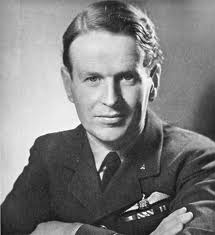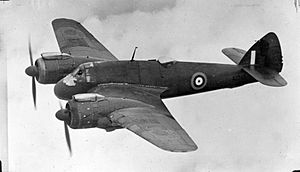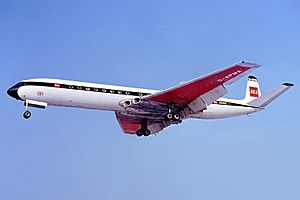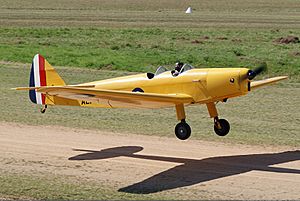John Cunningham (RAF officer) facts for kids
Quick facts for kids
John Cunningham
|
|
|---|---|

Wing Commander John Cunningham, 1942
|
|
| Nickname(s) | Cat's Eyes |
| Born | 27 July 1917 Croydon, Surrey, United Kingdom |
| Died | 21 July 2002 (aged 84) Welwyn Garden City, Hertfordshire, United Kingdom |
| Allegiance | United Kingdom |
| Service/ |
Royal Air Force (RAF) Royal Auxiliary Air Force (RAuxAF) |
| Years of service | 1936–1967 |
| Rank | Group captain |
| Unit | No. 604 Squadron RAF |
| Commands held | No. 85 Squadron RAF |
| Battles/wars | Second World War |
| Awards | Commander of the Order of the British Empire, Distinguished Service Order & two bars, Distinguished Flying Cross & bar, Mentioned in Despatches, Air Efficiency Award, Silver Star (United States), Order of the Patriotic War, 1st Class (USSR). |
John 'Cat's Eyes' Cunningham was a famous Royal Air Force (RAF) pilot. He was known as a night fighter ace during Second World War (WWII). He was also a skilled test pilot. People called him 'Cat's Eyes' because he was so good at seeing in the dark. This nickname helped hide the secret of radar from the enemy.
John Cunningham was born in Croydon, UK, on July 27, 1917. He always wanted to work in the aviation industry. He joined the de Havilland company as an engineering apprentice. At the same time, he joined the Royal Auxiliary Air Force (RAuxAF). This was a part-time branch of the RAF. He became a member of No. 604 Squadron.
Cunningham started his pilot training in August 1935. He flew solo for the first time in March 1936. By 1937, he had earned his pilot's wings. He became a junior test pilot and flew many different types of aircraft.
In August 1939, Cunningham rejoined his squadron. They were flying the Bristol Blenheim. His observer, Jimmy Rawnsley, helped him achieve most of his victories. In July 1940, his squadron became a special night fighter unit. They were among the first to get airborne interception radar (AI). Cunningham was promoted to squadron leader in September 1940.
He claimed his first victory on November 19, 1940. By June 1941, he had shot down thirteen enemy planes. He was promoted to wing commander in 1942. He also took command of No. 85 Squadron RAF. By then, he had sixteen victories. He added four more victories by early 1944. John Cunningham ended his combat career with twenty aerial victories. He spent the rest of the war in other roles. By May 1945, he was a group captain.
After the war, Cunningham returned to de Havilland. He continued his work as a test pilot. In 1949, he flew the world's first jet airliner, the de Havilland Comet. He also flew commercial jets in the 1960s and 1970s. He later worked as an executive director for British Aerospace (BAe). He retired in 1980. He was honored for his wartime service and his work in civil aviation.
Contents
Early Life and Flying Start
John Cunningham was born in Croydon, south London. This was on July 27, 1917. His father worked for the Dunlop Rubber Company. His mother's family owned an engineering company. John had two older sisters and a younger brother.
He went to Bowden House School and then Whitgift School. In 1926, he took a flight in an Avro 504. This made him want to join the school's officer training corps. His father passed away in 1930. John was good at school, especially in mathematics. As a teenager, he was very keen on aviation.
Becoming an Apprentice Pilot
At 18, John joined the de Havilland Aircraft company in 1935. He started as an apprentice engineer. He helped build planes like the de Havilland T.K.2 and de Havilland Moth Minor. At the same time, he joined the Royal Auxiliary Air Force (RAuxAF). This was a part-time branch of the Royal Air Force (RAF). He became a member of No. 604 (County of Middlesex) Squadron.
Cunningham began his pilot training in August 1935. He flew solo on March 15, 1936. He became a pilot officer on May 7, 1936. He earned his wings in the summer of 1936. This is when he met Cecil F. 'Jimmy' Rawnsley. Rawnsley was an electrical engineer. He would later be Cunningham's aerial gunner and radar operator.
Cunningham became a junior test pilot with de Havilland. He worked with Geoffrey de Havilland, the founder's son. Cunningham's flying experience grew quickly. He was promoted to flying officer in December 1937. He became one of de Havilland's top test pilots.
In March 1938, he was called to duty with 604 Squadron. This was during the Munich crisis. The squadron was flying the Hawker Demon. They later switched to the Bristol Blenheim. The Blenheim was originally a bomber. It was not ideal as a fighter. But the Air Ministry said it would work for night fighting. On April 20, 1938, he went back to de Havilland. He continued test-flying de Havilland Moth Minors.
On April 11, 1939, he had a close call. He and Geoffrey de Havilland had to parachute from a de Havilland Moth Minor. They were testing its response to spins. The plane stalled and went into a flat spin. They both bailed out. The plane then recovered and circled them as they descended! Luckily, it crashed before hitting them. Cunningham calmly took pictures of the wreckage. This showed his calm nature.
War became more likely in Europe. The RAF mobilized in August 1939. Cunningham had been test-flying the de Havilland Dragon airliner. He decided to join the RAF full-time. He felt he could be more useful flying for the RAF.
World War II Heroics
In August 1939, Cunningham rejoined his squadron. They were flying the Bristol Blenheim. He wasn't a big fan of the plane. The cockpit was cold, and the radios had short range. The windshield was hard to see through. The squadron had some losses due to these issues. In January 1940, 604 Squadron moved to RAF Northolt.
Cunningham was promoted to flight lieutenant in March 1940. In April, his squadron escorted a plane carrying Winston Churchill to Paris. Most of their time was spent training. On May 15, they moved to RAF Manston. From there, Cunningham flew patrols over the English Channel and Dunkirk. He didn't encounter any enemy planes. France surrendered on June 25.
Becoming a Night Fighter Ace
On July 26, 1940, the squadron became a special night fighter unit. They were among the first to get airborne interception radar (AI). Jimmy Rawnsley, Cunningham's friend, retrained as a radar operator. He rejoined Cunningham in January 1941. The Blenheim was often too slow to catch German bombers. No victories were claimed in the summer of 1940.
Cunningham was promoted to squadron leader in September 1940. He commanded B Flight. The unit soon received the powerful Bristol Beaufighter. Cunningham was the second person to fly it. He helped fix problems with the Beaufighter's gun sight. He also worked with ground control teams.
The AI radar sets were the first to be mass-produced. They had a range of about four miles. The minimum detection range was about 400 feet. Below 1000 feet, ground signals could block the screen. Operators like Rawnsley had to do a lot of guesswork.
The Cunningham–Rawnsley team used the AI to get directly behind and below the enemy. This allowed them to avoid the German gunners. Approaching from below also helped avoid the enemy's slipstream. This tactic let Cunningham get close and fire first. This usually ended the fight quickly.
The 'Cat's Eyes' Story
In autumn 1940, the Luftwaffe began bombing British cities. This was called The Blitz. On the night of November 19, 1940, the Germans raided Birmingham. Cunningham took off from RAF Middle Wallop. He was guided by radar to an enemy plane. He saw a Junkers Ju 88 bomber. He flew below it and fired his cannons. The bomber exploded and crashed. This was Cunningham's first victory.

He got his second victory on December 23, 1940. He shot down a Heinkel He 111 over Manchester. On January 2, 1941, he nearly got a third. He hit an He 111, but it escaped. On January 12, he damaged an He 111. Cunningham received the Distinguished Flying Cross (DFC) on January 28, 1941.
On February 9, 1941, Cunningham flew the de Havilland Mosquito for the first time. He was very impressed by it. He thought it would be a perfect replacement for the Bristol Beaufighter.
He claimed his third victory on February 15, 1941. He shot down an He 111 over Newton Abbot. It crashed outside Totnes. On April 3, 1941, he got his fourth victory. On April 7, he became a fighter ace by shooting down his fifth enemy plane. This was an He 111 attacking Portsmouth.
Two nights later, on April 9, he shot down another He 111. On April 11, he got another, plus a probable victory. On April 15, he had his most successful night. He shot down three bombers. He returned to base, then went out again. He shot down two more He 111s over Southampton and Lymington. In April, he was awarded his first Distinguished Service Order (DSO).
On May 7, 1941, Cunningham achieved his 12th victory in front of King George VI. The King visited his base and asked him to get another victory that night. Cunningham took off and intercepted an He 111. The King heard the battle from the ground. The Heinkel crashed near RAF Weston Zoyland. On May 31, Cunningham and Rawnsley shot down another He 111. This was during the last major raid of the Blitz. Cunningham was promoted to temporary squadron leader.
In early 1941, the British press wrote about Cunningham. This was to boost public morale. People thought the Germans could attack Britain freely at night. Publishing Cunningham's successes showed the RAF was fighting back. The Air Ministry did not want the enemy to know about radar. So, they created a story. They said Cunningham had amazing eyesight, like a cat. They also said eating carrots helped him see in the dark. Cunningham didn't like the attention, but he accepted the 'Cat's Eyes' nickname. The story worked, but it also made the Germans realize the RAF had something new.
Later War Service
The war changed in June 1941. Germany invaded the Soviet Union. This reduced German bomber attacks on Britain. Cunningham used this time to train new crews. He taught them to master their aircraft and radar. He also worked with scientists on new developments.
Cunningham continued to fly missions. In July, his Beaufighter was hit by return fire. One engine caught fire. He managed to fly back and land safely. In August 1941, he shot down an He 111. On September 1, he downed a Ju 88, his 15th victory. He received a bar to his DFC on September 19. By then, he was an acting wing commander.
The winter of 1941–42 was quiet. In spring 1942, Germany began the Baedeker Blitz. On April 4, Cunningham damaged an He 111 over Exeter. On May 23, 1942, he had a unique victory. He chased an He 111 for 150 minutes. The German pilot was very skilled at evading him. Cunningham forced the bomber down to 900 feet. The Heinkel then crashed without Cunningham firing a shot. He was promoted to temporary wing commander on June 1, 1942. He received a bar to his DSO on July 24 for this victory.
Cunningham and Rawnsley were then moved to staff positions. They tested the new AI Mk. VIII radar. This new radar was a big improvement. Cunningham became director of all training units. Rawnsley became an instructor. They were grounded for six months.
Final Combat Tour
In January 1943, Cunningham returned to operations. He commanded No. 85 Squadron RAF. They flew the de Havilland Mosquito NF.II. Jimmy Rawnsley was his operator again. The new radar made interceptions easier.
On March 3, 1943, Cunningham chased a Dornier Do 217. But his cannons jammed. The German crew realized he was there and escaped. Cunningham was frustrated. He brought in experienced personnel from his old unit. He then flew a Mosquito NF.XII with improved radar.
The Luftwaffe started sending fast Focke-Wulf Fw 190 fighters at night. These were hard to intercept. On June 13, 1943, Cunningham intercepted an Fw 190 near West Malling. He shot it down. The German pilot parachuted out with a broken arm.
On August 23, he claimed another Fw 190. On September 8/9, he got his 19th victory, an Fw 190A-5. His 20th and final victory was on January 2/3, 1944. He chased a Messerschmitt Me 410 to France and shot it down.
In January 1944, the Luftwaffe launched Operation Steinbock. Cunningham claimed a Junkers Ju 188 damaged on February 20/21. On February 23/24, he claimed a probable Ju 188. During one mission, a German gunner hit his windscreen. Glass fragments struck Cunningham's face. He later learned Germans were using new radar to detect night fighters.
On March 3, 1944, he received another bar to his DSO. On April 11, 1944, the Soviet Union awarded him the Order of the Patriotic War, 1st Class.
Post-War Leadership
In March 1944, Cunningham left command of 85 Squadron. He was appointed group captain in charge of Night Operations at No. 11 Group RAF. At 26, he was one of the youngest to hold this rank. He also test-flew the de Havilland Vampire. He thought it would make a great night fighter.
On June 13, 1944, the V-1 flying bomb offensive began. Cunningham helped with their interception. He was worried about the V-1s exploding and damaging the attacking fighters. One of his former commanders had to bail out when his Mosquito was damaged. By August 1944, the Mosquitoes were back on bomber support missions. He was promoted to wing commander (war-substantive) on September 1, 1944.
Towards the end of the war, he flew throughout Europe. He flew many different types of planes, including Supermarine Spitfires. He remained with 11 Group until Germany surrendered on May 8, 1945.
In July 1945, he went to the Far East. He was part of a group to recover Singapore from the Japanese. But then the atomic attacks happened, and Japan surrendered. The war was over. Cunningham was offered a permanent role in the RAF. But he wanted to keep flying, not just do administration. So, he decided to return to de Havilland. He officially left the RAF in November 1945.
Life After the War
Cunningham officially left his RAF commission on August 1, 1946. He kept the rank of group captain. He also stayed in the Royal Auxiliary Air Force (RAuxAF) as a reserve officer until 1967.
At de Havilland, he became chief test pilot. He helped with deals to sell de Havilland Vampires to the Swedish Air Force and Swiss Air Force. In 1990, the Swiss gave him a special gift when they retired their Vampires.
On September 27, 1946, Geoffrey de Havilland Jr. died test-flying a plane. Cunningham took over his role. In March 1948, he set a world flight altitude record of 59,430 feet in a Vampire. The next year, he test-flew the de Havilland Comet, the world's first jet airliner. It first flew on July 27, 1949.

In 1951, Cunningham was made an Officer of the Order of the British Empire (OBE). He was promoted to Commander of the Order of the British Empire (CBE) in 1963. On May 23, 1952, he flew the Comet with the Queen Mother and Princess Margaret. He even let the Queen Mother take the controls for a bit. Cunningham continued to test new Comet models in the 1950s. In 1955, he won the Gold Medal of the Royal Aero Club. In 1956, he received the Harmon Trophy from President Dwight D. Eisenhower. This was a top American award for civil aviation.
In 1958, he joined the de Havilland board. But the company merged with Hawker Siddeley in 1960. He helped develop the Hawker Siddeley Trident in 1962. He also advised the Chinese Government from 1972 to 1979. He helped sell aircraft to China. He delayed his retirement to complete these sales. In 1975, the British Government took over the industry. British Aerospace (BAe) was formed.
Cunningham had one serious accident while flying. On November 20, 1975, birds flew into the engines of his plane after takeoff. He had to make an emergency landing. He suffered two crushed vertebra. He remained chief test pilot until 1978. He retired from British Aerospace in 1980.
In retirement, Cunningham worked for aviation charities. He became Chairman of the Sir Geoffrey de Havilland Flying Foundation. This charity helps young people interested in aviation. He faced financial difficulties later in life. John Cunningham never married. He passed away on July 21, 2002, at age 84.
Awards and Recognition
John Cunningham received many honors. He was appointed a Commander of the Order of the British Empire (CBE) in 1963. This was for his wartime service and his work in civil aviation. He also received the Segrave Trophy in 1978.
Medals Sold for Charity
After Cunningham's death, his medals and flying items went to the de Havilland Aircraft Company Trust. On September 6, 2012, his medals were sold for £384,000. The money raised helps fund an education center, museum, and flying scholarships for young people.



